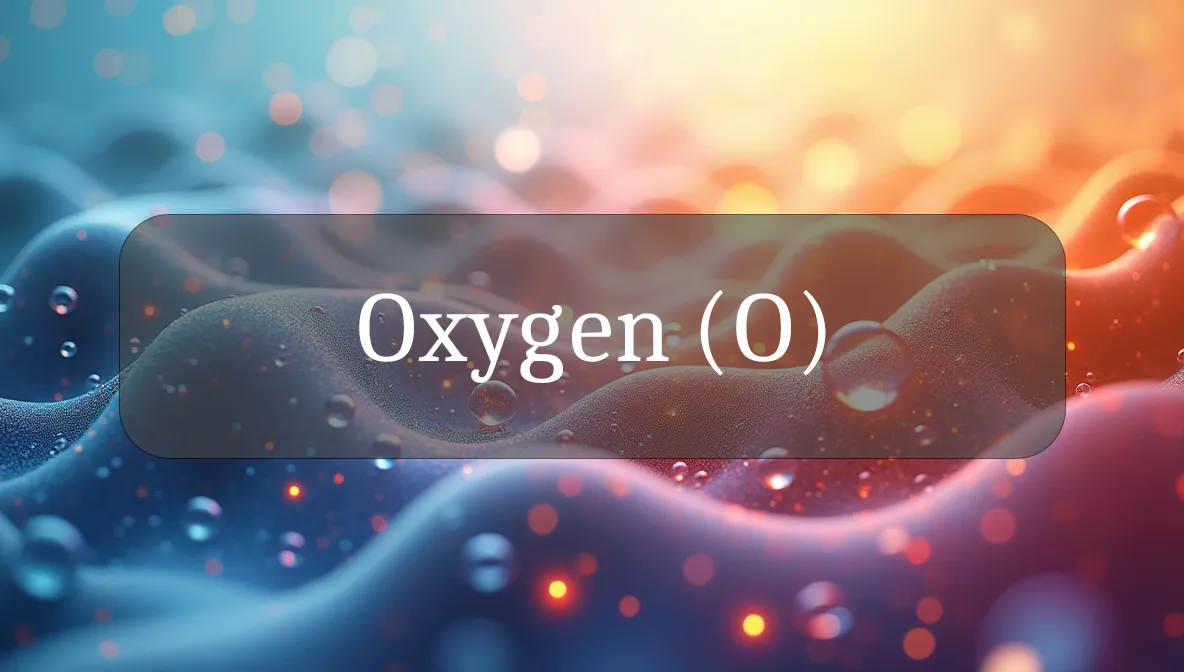Breath of Life for Your Body’s Vitality
Oxygen is the invisible force that keeps you alive, powering every cell in your body with every breath you take. It’s not just about breathing—it’s about fueling energy, healing wounds, and keeping your brain sharp. Found in the air and woven into the food you eat, oxygen is a cornerstone of wellness. Let’s explore why oxygen is so essential and how to ensure your body gets enough to thrive every day.
Chemical Identity and Role
Oxygen (O) is a colorless, odorless gas, number 8 on the periodic table, making up about 21% of the air you breathe. It’s a highly reactive element, forming bonds with other elements to create vital molecules like water (H₂O), carbon dioxide (CO₂), and proteins. In your body, oxygen is a key player in energy production and cellular health, carried by your blood to every tissue.
Biological Role and Health Impact
Oxygen is your body’s lifeline, with critical roles in keeping you healthy:
- Energy Production: Oxygen is used in your cells’ powerhouses (mitochondria) to turn food (like glucose) into energy (ATP), fueling everything from your heartbeat to your daily run.
- Brain Function: Your brain uses about 20% of your body’s oxygen to support thinking, memory, and focus.
- Healing and Immunity: Oxygen helps white blood cells fight infections and supports tissue repair, like healing cuts or rebuilding muscles after exercise.
- Detoxification: It aids in breaking down toxins and waste, keeping your body clean and balanced.
Without enough oxygen, your cells can’t function properly, leading to fatigue, confusion, or worse. It’s essential for life and vitality.
Sources (Dietary or Environmental)
Oxygen is abundant and comes from both the environment and your diet:
- Environmental Sources:
- Air: The primary source, providing oxygen through breathing (21% of air is O₂). Fresh, clean air is ideal.
- Water: Oxygen is part of water (H₂O), which makes up ~60% of your body, supporting hydration and cell function.
- Dietary Sources:
- All foods contain oxygen in their molecular structure (e.g., carbs, proteins, fats), indirectly supporting oxygen-related processes like metabolism.
- Water-rich foods like fruits (e.g., apples, ~85% water) and vegetables (e.g., spinach, ~90% water) contribute oxygen via H₂O.
- Supplemental Sources:
- Oxygen therapy (e.g., hyperbaric chambers or portable oxygen) is used medically for lung conditions or wound healing but isn’t needed for healthy people.
Deep breathing and a balanced diet naturally provide all the oxygen your body needs.
Deficiency/Excess Signs
Oxygen imbalances can affect your health, though true deficiency or excess is rare in healthy people:
- Deficiency Signs (Hypoxia):
- Shortness of breath, rapid breathing, or wheezing.
- Fatigue, dizziness, or confusion.
- Blue lips or fingertips (cyanosis) in severe cases.
- Causes include lung conditions (e.g., asthma, COPD), high altitudes, or poor air quality.
- Excess Signs (Hyperoxia):
- Rare but can occur with supplemental oxygen (e.g., in medical settings), causing lung irritation, seizures, or oxidative stress (cell damage from too much oxygen).
- Breathing pure oxygen for too long (e.g., during diving) can lead to toxicity, causing nausea or vision issues.
- Metabolic Imbalance: Poor oxygen delivery (e.g., from anemia or heart issues) can mimic deficiency, causing weakness or pale skin.
Most people get enough oxygen through normal breathing, but lifestyle or health conditions can affect how it’s used.
Supporting Optimal Levels
You can optimize oxygen’s benefits with these practical tips:
- Breathe Deeply: Practice diaphragmatic breathing (slow, deep belly breaths) to boost oxygen intake. Try 5–10 minutes daily, especially in fresh air.
- Stay Active: Exercise like walking, swimming, or yoga increases lung capacity and oxygen delivery to tissues. Aim for 150 minutes of moderate activity weekly.
- Eat a Balanced Diet: Foods rich in iron (e.g., spinach, red meat) and antioxidants (e.g., berries, nuts) support oxygen transport and protect cells from damage.
- Stay Hydrated: Water (containing oxygen) keeps blood flowing smoothly, aiding oxygen delivery. Aim for 8–10 cups daily.
- Improve Air Quality: Avoid smoking, use air purifiers indoors, and spend time in green spaces with clean air.
- Monitor Health Conditions: If you have lung, heart, or blood disorders, work with a doctor to optimize oxygen levels (e.g., via inhalers or therapy).
- Avoid High-Risk Situations: At high altitudes or in polluted areas, take precautions like pacing activity or using oxygen support if needed.
Healthy lungs and a strong heart ensure your body uses oxygen efficiently.
Safety, Interactions, and Precautions
Oxygen is safe and essential, but here are some considerations:
- Interactions:
- Medications: Drugs for lung or heart conditions (e.g., bronchodilators) affect oxygen use. Follow your doctor’s guidance.
- Nutrients: Iron and vitamin B12 support red blood cells, which carry oxygen. Deficiencies can reduce oxygen delivery, so eat a varied diet.
- Precautions:
- Avoid smoking or secondhand smoke, which damages lungs and reduces oxygen uptake.
- Be cautious with supplemental oxygen (e.g., in medical settings). Overuse can harm lungs or cause dependency—use only under medical supervision.
- Environmental hazards like carbon monoxide (CO) can block oxygen use, causing poisoning. Ensure good ventilation and use CO detectors.
- Who’s at Risk? People with lung diseases (e.g., COPD, asthma), heart conditions, or anemia may struggle with oxygen delivery and need medical support.
Fun Fact
Oxygen is a gift from ancient microbes! Billions of years ago, tiny cyanobacteria started producing oxygen through photosynthesis, transforming Earth’s atmosphere and making life as we know it possible. Every breath you take is a legacy of those early life forms!
Citations
- National Institutes of Health. (2025). Oxygen and Human Physiology. National Library of Medicine.
- Mayo Clinic. (2024). Oxygen Therapy: Benefits and Risks.
- World Health Organization. (2023). Air Quality and Respiratory Health.
- Cleveland Clinic. (2023). How Your Lungs Work and Why Oxygen Matters.
- USDA FoodData Central. (2025). Water and Nutrient Content in Foods.

